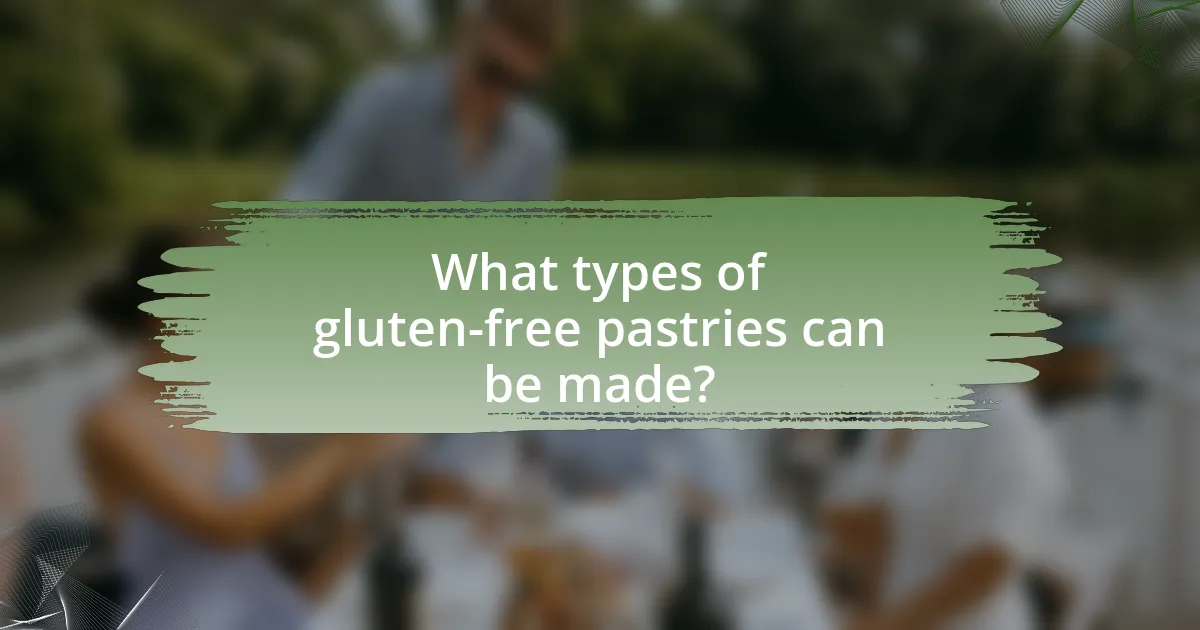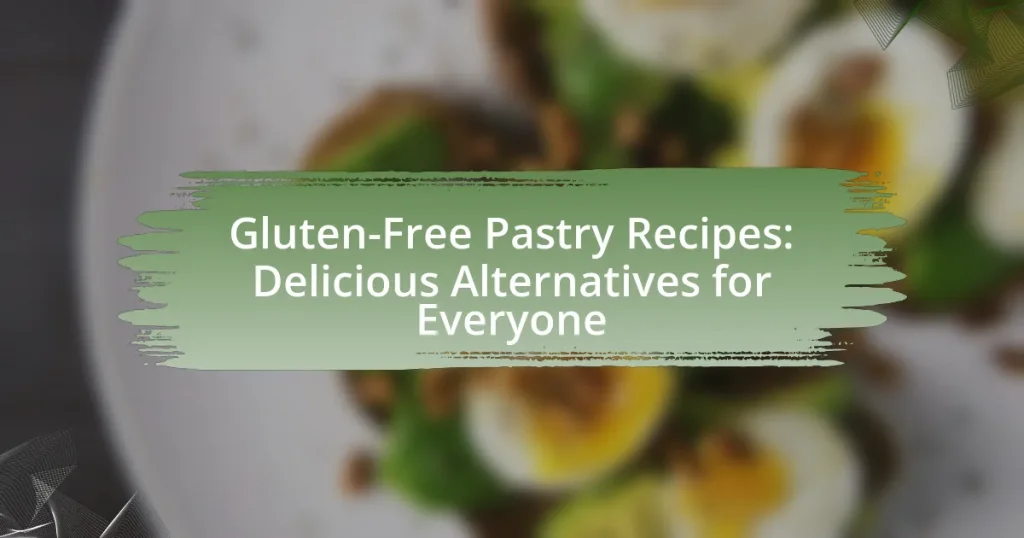Gluten-free pastry recipes are baked goods made without gluten-containing ingredients, catering to individuals with gluten sensitivities or celiac disease. This article explores the differences between gluten-free and traditional pastry recipes, highlighting the alternative flours and binding agents used to achieve desirable textures and flavors. It discusses the importance of gluten-free pastries for those with specific dietary needs, the types of pastries that can be made, and techniques for preparing gluten-free dough. Additionally, it provides insights into common mistakes to avoid, resources for gluten-free baking, and best practices for storing gluten-free pastries.

What are Gluten-Free Pastry Recipes?
Gluten-free pastry recipes are baked goods made without gluten-containing ingredients, primarily wheat, barley, or rye. These recipes utilize alternative flours such as almond flour, coconut flour, or rice flour to create pastries that cater to individuals with gluten sensitivities or celiac disease. The demand for gluten-free options has increased, with studies indicating that approximately 1% of the global population is affected by celiac disease, necessitating the need for safe and delicious alternatives in baking.
How do gluten-free pastry recipes differ from traditional recipes?
Gluten-free pastry recipes differ from traditional recipes primarily in the type of flour used, as they replace wheat flour with gluten-free alternatives such as almond flour, coconut flour, or rice flour. These substitutions affect the texture and structure of the pastry, often resulting in a denser or crumblier product compared to the elasticity and chewiness provided by gluten in traditional recipes. Additionally, gluten-free recipes may require the use of binding agents like xanthan gum or psyllium husk to mimic the properties of gluten, ensuring that the pastry holds together properly.
What ingredients are commonly used in gluten-free pastries?
Common ingredients used in gluten-free pastries include almond flour, coconut flour, rice flour, and tapioca starch. These ingredients serve as substitutes for traditional wheat flour, providing structure and texture to the pastries. Almond flour is high in protein and healthy fats, while coconut flour is rich in fiber. Rice flour offers a neutral flavor and is often used in combination with other gluten-free flours to achieve the desired consistency. Tapioca starch adds chewiness and helps bind the ingredients together, making it a popular choice in gluten-free baking.
How do these ingredients affect the texture and flavor of pastries?
Gluten-free ingredients significantly alter the texture and flavor of pastries by replacing traditional wheat flour with alternatives like almond flour, coconut flour, or rice flour. These substitutes often result in a denser texture and can impart unique flavors; for instance, almond flour adds a nutty taste, while coconut flour contributes a subtle sweetness. Additionally, gluten-free pastries may require binding agents such as xanthan gum or psyllium husk to mimic the elasticity and structure provided by gluten, which can further influence the final texture. Studies show that the choice of gluten-free flour impacts moisture retention and crumb structure, leading to variations in both mouthfeel and taste profiles in baked goods.
Why are gluten-free pastries important for certain diets?
Gluten-free pastries are important for certain diets primarily because they provide safe food options for individuals with celiac disease or gluten sensitivity. Celiac disease affects approximately 1% of the global population, causing severe health issues when gluten is consumed. Gluten-free pastries allow these individuals to enjoy baked goods without risking adverse health effects, thus supporting their dietary needs and overall well-being.
Who benefits from gluten-free pastry options?
Individuals with celiac disease and gluten sensitivity benefit from gluten-free pastry options. Celiac disease affects approximately 1% of the global population, causing severe reactions to gluten, a protein found in wheat, barley, and rye. Gluten sensitivity, which affects a broader range of individuals, can lead to discomfort and digestive issues when gluten is consumed. By providing gluten-free alternatives, these individuals can enjoy pastries without adverse health effects, ensuring they have safe and enjoyable food choices.
What health conditions necessitate a gluten-free diet?
Celiac disease, non-celiac gluten sensitivity, and wheat allergy necessitate a gluten-free diet. Celiac disease is an autoimmune disorder where ingestion of gluten leads to damage in the small intestine, affecting nutrient absorption. Non-celiac gluten sensitivity involves gastrointestinal and extra-intestinal symptoms triggered by gluten without the autoimmune response seen in celiac disease. Wheat allergy is an allergic reaction to proteins found in wheat, including gluten, which can cause severe reactions. These conditions require strict adherence to a gluten-free diet to manage symptoms and prevent complications.

What types of gluten-free pastries can be made?
Various types of gluten-free pastries can be made, including almond flour muffins, coconut flour cookies, and rice flour tarts. These pastries utilize alternative flours that do not contain gluten, allowing individuals with gluten sensitivities or celiac disease to enjoy baked goods. For instance, almond flour is rich in protein and healthy fats, making it a popular choice for moist muffins, while coconut flour is highly absorbent, ideal for creating light and fluffy cookies. Additionally, rice flour can be used to create a flaky crust for tarts, providing a versatile base for sweet or savory fillings.
How can gluten-free dough be prepared for various pastries?
Gluten-free dough for various pastries can be prepared by combining gluten-free flour blends, such as rice flour, almond flour, or tapioca flour, with binding agents like xanthan gum or psyllium husk to mimic the elasticity of gluten. The mixture should include a fat source, such as butter or coconut oil, and a liquid, typically water or milk, to achieve the desired consistency.
For example, a common ratio is two cups of gluten-free flour blend, one teaspoon of xanthan gum, half a cup of butter, and one cup of liquid. This combination creates a workable dough suitable for rolling and shaping into pastries. The effectiveness of gluten-free flour blends has been supported by studies indicating that they can yield textures comparable to traditional wheat-based doughs when properly formulated.
What are the best techniques for rolling and shaping gluten-free dough?
The best techniques for rolling and shaping gluten-free dough include using a combination of moisture, fat, and appropriate flour blends. Gluten-free dough often requires additional moisture to achieve the right consistency, so incorporating ingredients like eggs or yogurt can help. Using a rolling pin with parchment paper or a silicone mat prevents sticking and allows for easier handling. Additionally, chilling the dough before rolling can enhance its firmness and make it easier to shape.
Research indicates that using a blend of gluten-free flours, such as almond flour, coconut flour, and tapioca starch, can improve the texture and elasticity of the dough, making it more manageable. This approach is supported by findings from the “Journal of Food Science,” which highlights the importance of ingredient ratios in gluten-free baking for achieving desirable results.
How does baking time and temperature differ for gluten-free pastries?
Baking time and temperature for gluten-free pastries typically differ from traditional pastries due to the absence of gluten, which affects moisture retention and structure. Gluten-free pastries often require lower baking temperatures, usually around 25°F (14°C) less than standard recipes, and may need longer baking times to ensure thorough cooking and proper texture. This adjustment is necessary because gluten-free flours, such as almond or coconut flour, absorb more moisture and can lead to denser products if not baked correctly.
What are some popular gluten-free pastry recipes?
Popular gluten-free pastry recipes include almond flour pastries, coconut flour tarts, and gluten-free puff pastry. Almond flour pastries are made using finely ground almonds, providing a rich flavor and texture, while coconut flour tarts utilize coconut flour, which is high in fiber and low in carbohydrates. Gluten-free puff pastry is often created with a blend of gluten-free flours, such as rice flour and tapioca starch, allowing for a flaky and light texture similar to traditional puff pastry. These recipes cater to those with gluten sensitivities and offer delicious alternatives without compromising taste or texture.
How can one make gluten-free pie crusts?
To make gluten-free pie crusts, combine gluten-free flour, such as almond or rice flour, with a fat source like butter or coconut oil, and a binding agent such as eggs or applesauce. This mixture should be blended until it forms a dough that holds together. The dough can then be pressed into a pie pan and pre-baked or filled as desired. Gluten-free flours often require additional moisture or binding agents to achieve the right texture, as they lack gluten, which provides elasticity in traditional crusts.
What are the steps to create gluten-free cookies and brownies?
To create gluten-free cookies and brownies, first gather gluten-free flour, sugar, eggs, butter, and any additional flavorings or mix-ins like chocolate chips or nuts. Begin by preheating the oven to the appropriate temperature, usually around 350°F (175°C).
For cookies, mix the dry ingredients, including gluten-free flour and baking powder, in one bowl, and the wet ingredients, such as melted butter and eggs, in another. Combine both mixtures until a dough forms, then scoop onto a baking sheet and bake for 10-12 minutes.
For brownies, combine the dry ingredients in one bowl and the wet ingredients in another, then mix them together until smooth. Pour the batter into a greased baking pan and bake for 20-25 minutes.
These steps ensure that the cookies and brownies are both gluten-free and delicious, catering to those with gluten sensitivities.

What tips can enhance gluten-free pastry baking?
To enhance gluten-free pastry baking, use a blend of gluten-free flours for better texture and flavor. Combining flours such as almond, coconut, and rice flour can create a more balanced structure, as each type contributes unique properties. Additionally, incorporating xanthan gum or guar gum helps mimic the elasticity of gluten, improving the overall consistency of the pastry. Research indicates that using these binding agents can significantly enhance the texture of gluten-free baked goods, making them less crumbly and more cohesive.
How can one ensure the best results when baking gluten-free pastries?
To ensure the best results when baking gluten-free pastries, one should use a combination of gluten-free flours, such as almond flour or coconut flour, and incorporate binding agents like xanthan gum or psyllium husk. These ingredients help mimic the structure and texture that gluten provides in traditional pastries. Research indicates that using a blend of different gluten-free flours can enhance flavor and texture, as each type contributes unique properties. For instance, a study published in the Journal of Food Science found that combining rice flour with tapioca flour improved the overall quality of gluten-free baked goods. Additionally, proper hydration and allowing the dough to rest can further improve the final product’s texture and moisture retention.
What common mistakes should be avoided in gluten-free pastry baking?
Common mistakes to avoid in gluten-free pastry baking include using only one type of gluten-free flour, neglecting to add binders, and not adjusting liquid ratios. Relying solely on a single flour, such as almond or coconut, can lead to undesirable textures, as each flour has unique properties. Incorporating binders like xanthan gum or psyllium husk is essential for mimicking gluten’s elasticity, which is crucial for structure. Additionally, gluten-free flours often absorb more liquid than wheat flour, so adjusting the liquid content is necessary to achieve the right consistency. These practices are supported by baking experts who emphasize the importance of flour blends and proper hydration in successful gluten-free baking.
How can one adapt traditional recipes to be gluten-free?
To adapt traditional recipes to be gluten-free, one can substitute wheat flour with gluten-free alternatives such as almond flour, coconut flour, or gluten-free all-purpose flour blends. These substitutes maintain the texture and flavor of the original recipe while eliminating gluten. For instance, almond flour is high in protein and adds moisture, while coconut flour absorbs more liquid and may require additional eggs or liquids to achieve the desired consistency. Research indicates that gluten-free flours can effectively replace wheat flour in various recipes, allowing for successful adaptations without compromising taste or quality.
What resources are available for gluten-free pastry enthusiasts?
Gluten-free pastry enthusiasts can access a variety of resources, including specialized cookbooks, online recipe websites, and dedicated gluten-free baking blogs. Cookbooks such as “Gluten-Free Artisan Bread in Five Minutes a Day” by Jeff Hertzberg and Zoë François provide comprehensive recipes and techniques tailored for gluten-free baking. Websites like Gluten-Free Girl and America’s Test Kitchen offer extensive recipe collections and tips specifically for gluten-free pastries. Additionally, social media platforms and forums allow enthusiasts to share experiences, recipes, and troubleshooting advice, fostering a community of support and knowledge.
Where can one find reliable gluten-free pastry recipes?
Reliable gluten-free pastry recipes can be found on reputable cooking websites such as King Arthur Baking, Gluten-Free Girl, and America’s Test Kitchen. These sources are known for their tested and verified recipes, ensuring quality and reliability. King Arthur Baking, for instance, offers a wide range of gluten-free recipes that have been developed by experts in the field, while Gluten-Free Girl provides personal insights and adaptations for various pastries. America’s Test Kitchen is recognized for its rigorous testing process, which guarantees that the recipes are both delicious and dependable.
What are some recommended cookbooks or websites for gluten-free baking?
Some recommended cookbooks for gluten-free baking include “Gluten-Free Artisan Bread in Five Minutes a Day” by Jeff Hertzberg and Zoë François, which provides easy recipes for bread, and “The How Can It Be Gluten-Free Cookbook” by America’s Test Kitchen, known for its tested recipes. Websites such as Gluten-Free Girl and King Arthur Baking offer extensive resources, recipes, and tips for gluten-free baking. These sources are recognized for their reliability and comprehensive approach to gluten-free cooking, making them valuable for anyone looking to explore gluten-free baking.
What are the best practices for storing gluten-free pastries?
The best practices for storing gluten-free pastries include keeping them in an airtight container at room temperature for short-term storage or refrigerating them for longer freshness. Gluten-free pastries tend to dry out quickly, so using an airtight container helps maintain moisture. For optimal preservation, freezing is recommended; wrap the pastries tightly in plastic wrap and then place them in a freezer-safe bag, which can extend their shelf life for several months. Studies show that proper storage methods can significantly reduce staleness and maintain texture, ensuring that gluten-free pastries remain enjoyable for consumption.




